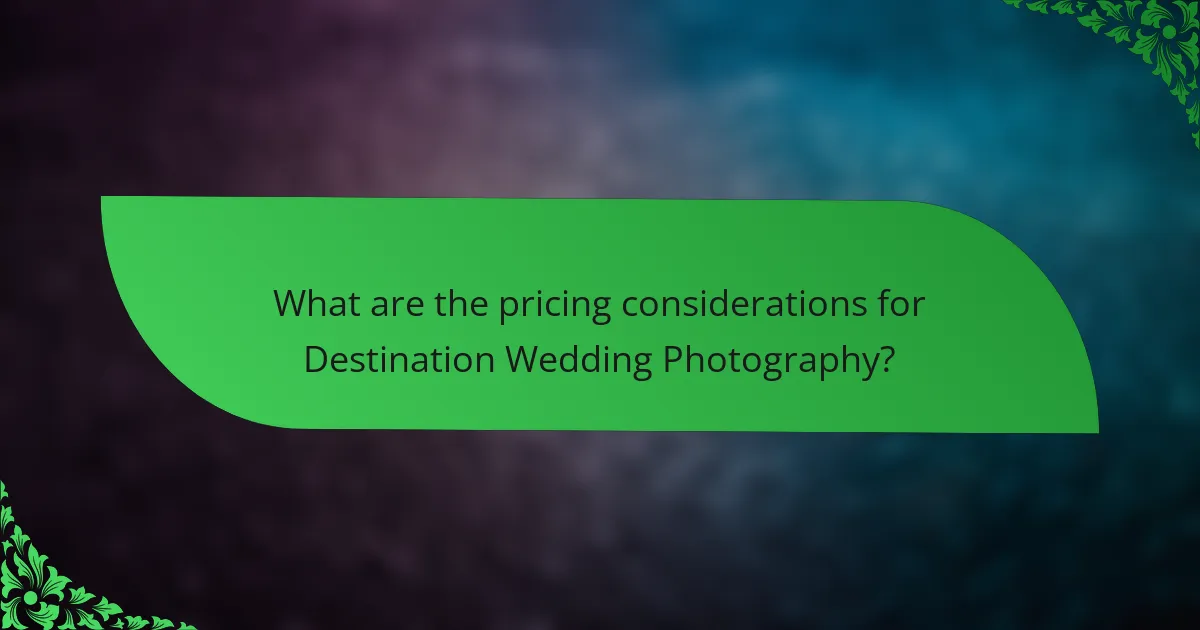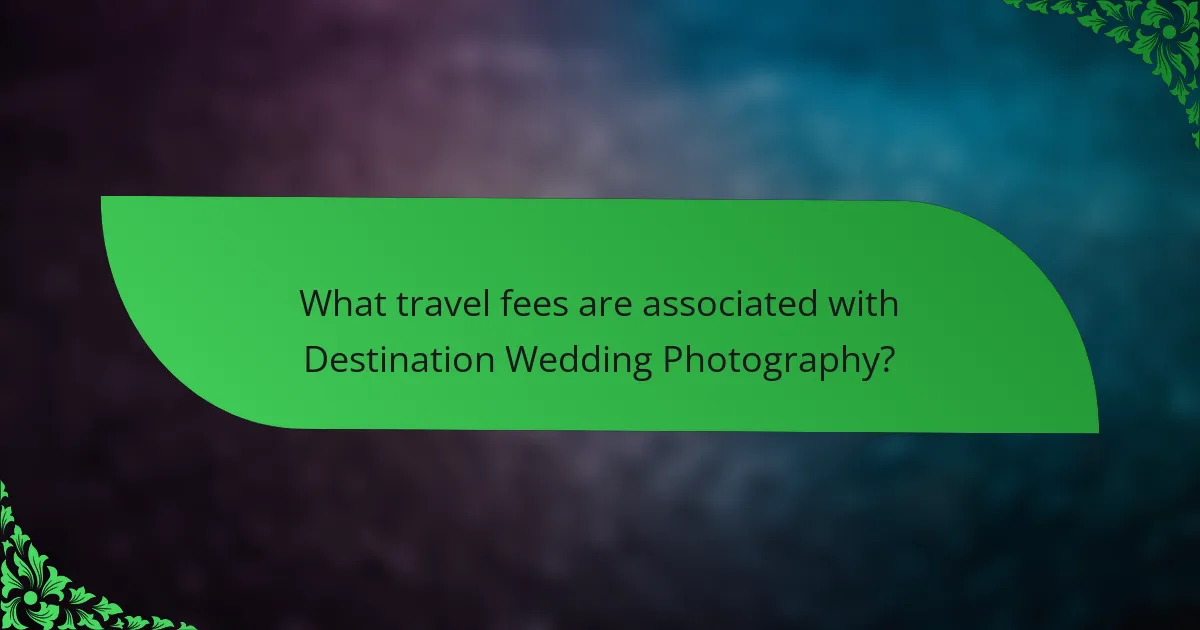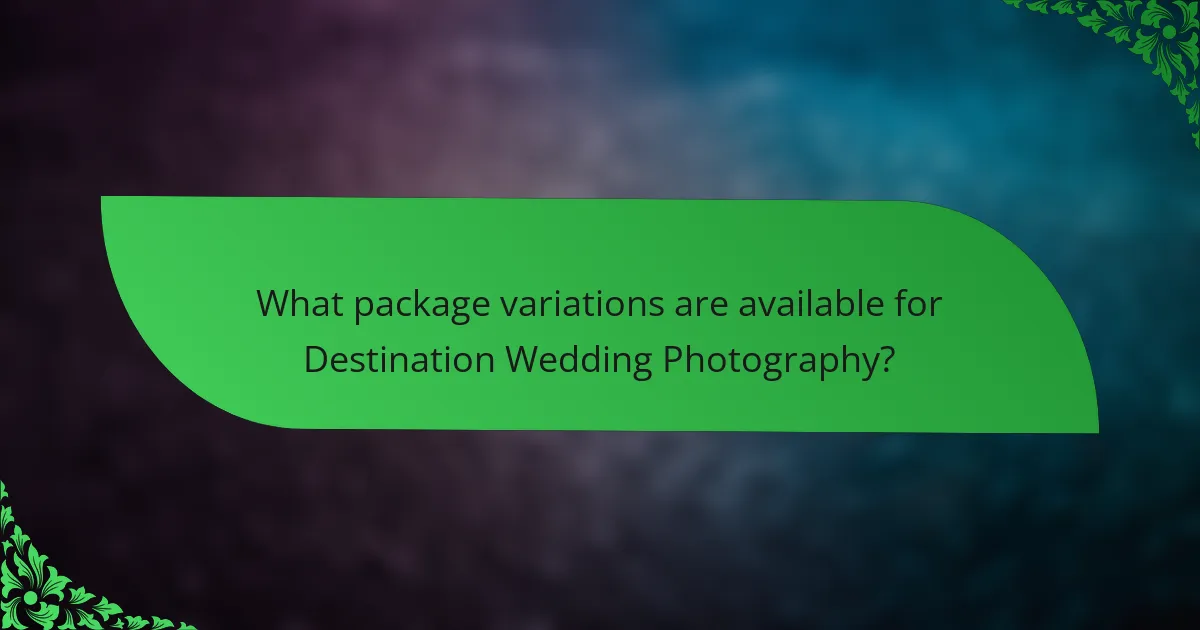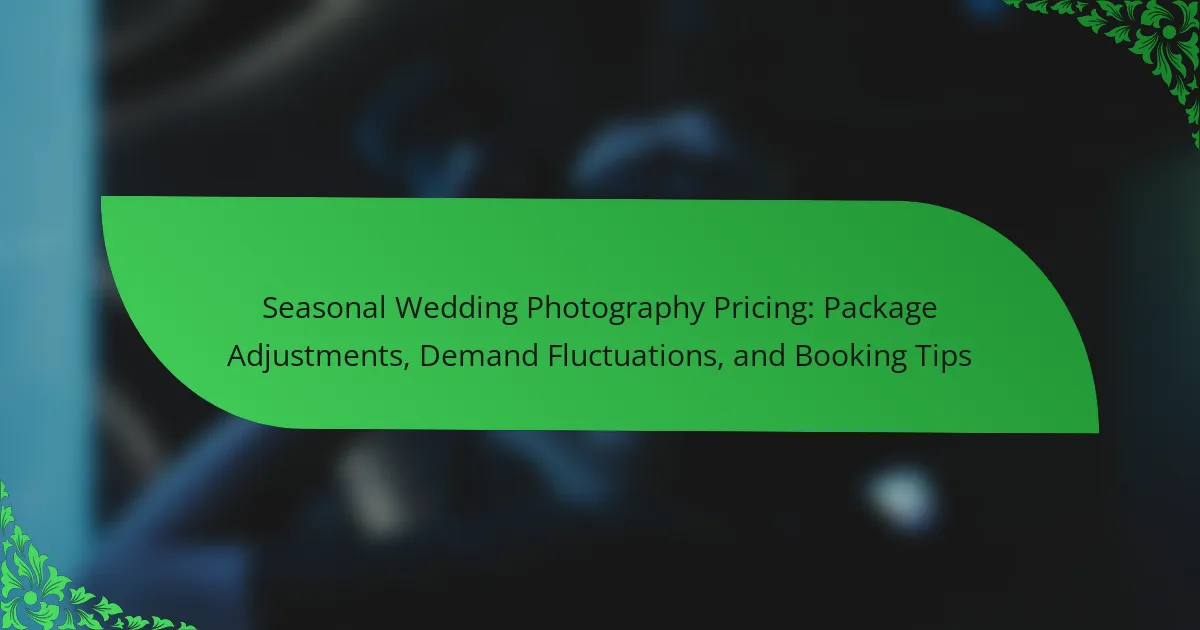Destination wedding photography is a specialized service that captures weddings held in unique locations away from the couple’s hometown, focusing on the event’s atmosphere, scenery, and emotions. This article outlines the key pricing considerations for destination wedding photography, including travel expenses, location influence, package variations, and the photographer’s experience. It also details common travel fees associated with this service, which encompass airfare, accommodation, and local transportation. Additionally, the article discusses the various photography packages available, ranging from basic to premium options, and highlights the importance of customizing these packages to meet client needs and budgets.

What is Destination Wedding Photography?
Destination wedding photography is a specialized service that captures weddings held in unique locations away from the couple’s hometown. This type of photography focuses on documenting the event’s atmosphere, scenery, and emotions in picturesque settings. Destination wedding photographers often travel to various locations, such as beaches, mountains, or historic cities, to provide couples with stunning visual memories. The service typically includes pre-wedding consultations, travel arrangements, and customized photography packages tailored to the specific destination. Many destination wedding photographers possess experience in handling different lighting conditions and cultural elements unique to various regions. This expertise ensures high-quality images that reflect the essence of the wedding and its surroundings.
How does Destination Wedding Photography differ from traditional wedding photography?
Destination wedding photography focuses on capturing weddings held in unique locations away from the couple’s home. Traditional wedding photography typically involves ceremonies and receptions at local venues. Destination photographers often need to account for travel logistics, including airfare and accommodation, which can influence pricing. In contrast, traditional photographers usually operate within a fixed geographical area, minimizing travel costs. The style of destination photography may emphasize the surrounding environment, incorporating scenic backdrops that enhance the images. Traditional photography may concentrate more on the event itself, with less emphasis on external locations. Additionally, destination photographers may offer specialized packages tailored to the unique aspects of travel and location. Traditional packages generally focus on standard services offered within the local market.
What unique challenges does Destination Wedding Photography present?
Destination wedding photography presents unique challenges such as logistical coordination and varying weather conditions. Photographers must manage travel arrangements, including flights and accommodations, which can complicate planning. Additionally, unfamiliar locations may limit access to venues and resources. Communication barriers may arise with local vendors and clients. Cultural differences can also impact photography styles and expectations. Lastly, photographers may face time constraints due to tight schedules and limited daylight. Each of these factors contributes to the complexity of capturing destination weddings effectively.
How do cultural differences influence Destination Wedding Photography?
Cultural differences significantly influence destination wedding photography. They shape the styles, themes, and rituals captured in photographs. For instance, traditional ceremonies in different cultures may require specific poses or settings. A Hindu wedding often features vibrant colors and elaborate decorations, while a Western wedding may focus on simplicity and elegance.
Additionally, cultural customs dictate the moments that photographers prioritize. In some cultures, capturing family portraits is crucial, while others emphasize candid moments. Moreover, cultural preferences can affect the choice of locations and backdrops. For example, a beach setting may be popular in tropical cultures, while historical venues are favored in others.
Photographers must also adapt to local etiquette and traditions during shoots. Understanding these differences ensures respectful and meaningful representation of the couple’s heritage. Ultimately, cultural influences create diverse and personalized wedding photography experiences.
What are the key elements of Destination Wedding Photography?
Key elements of destination wedding photography include location, style, and planning. The location is crucial as it influences the overall aesthetic of the photographs. Popular destinations often provide stunning backdrops, such as beaches, mountains, or historic venues. The style of photography should align with the couple’s vision, whether it be traditional, candid, or artistic. Planning involves coordinating with local vendors and understanding travel logistics. This ensures that the photographer can capture the event seamlessly. Additionally, knowledge of local customs and lighting conditions is essential for optimal results.
What types of shots are essential for Destination Wedding Photography?
Essential shots for destination wedding photography include wide-angle venue shots, intimate couple portraits, and candid guest interactions. Wide-angle venue shots capture the scenery and ambiance of the location. Intimate couple portraits highlight the couple’s emotions and connection. Candid guest interactions document the joy and celebration among attendees. Detail shots of decor and rings showcase the wedding’s unique elements. Group family portraits are important for preserving memories with loved ones. Finally, sunset or golden hour shots enhance the romantic feel of the photographs. These types of shots are crucial for creating a comprehensive visual story of the wedding day.
How does the location impact the photography style and approach?
Location significantly impacts photography style and approach. Different environments influence lighting, composition, and subject matter. For instance, a beach setting may emphasize natural light and vibrant colors. In contrast, an urban location might focus on architectural elements and unique angles. The cultural context of a location can also dictate themes and poses. Photographers often adapt their techniques to suit the surroundings. This adaptability enhances storytelling through imagery. Ultimately, the location shapes the overall aesthetic and emotional tone of the photographs.

What are the pricing considerations for Destination Wedding Photography?
Pricing considerations for destination wedding photography include several key factors. First, travel expenses significantly impact overall costs. Photographers may charge for airfare, accommodation, and transportation. Second, location influences pricing. Popular destinations may have higher rates due to demand. Third, package variations can affect costs. Different packages may offer varying levels of service and coverage. Fourth, the photographer’s experience and reputation play a role. Highly experienced photographers typically charge more for their expertise. Lastly, additional services such as engagement shoots or albums can increase the total price. These factors collectively determine the final pricing for destination wedding photography.
How do photographers determine their pricing for Destination Wedding Photography?
Photographers determine their pricing for Destination Wedding Photography based on several key factors. First, they consider their experience and skill level. More experienced photographers typically charge higher rates. Next, they evaluate the location and travel costs associated with the wedding. Traveling to remote or international destinations can significantly increase expenses.
Additionally, photographers assess the time required for the shoot and post-production work. Longer events or complex editing processes can lead to higher fees. They also take into account the type of packages offered. Comprehensive packages that include additional services, such as engagement shoots or albums, tend to be priced higher.
Market research is another important factor. Photographers often analyze competitors’ pricing to ensure their rates are competitive. Finally, client budgets and expectations play a crucial role in pricing decisions. Photographers aim to align their services with what clients are willing to spend. This multi-faceted approach ensures that the pricing reflects the unique demands of each destination wedding.
What factors influence the overall cost of Destination Wedding Photography?
The overall cost of Destination Wedding Photography is influenced by several key factors. First, the photographer’s experience and reputation significantly affect pricing. Established photographers often charge higher rates due to their portfolio and demand. Second, travel expenses play a crucial role. Costs include airfare, accommodation, and transportation to the wedding location. Third, the duration of the event impacts the total cost. Longer events require more hours of coverage, leading to increased fees. Fourth, the complexity of the wedding can influence pricing. Unique locations or special requests may necessitate additional resources or equipment. Lastly, package variations offered by photographers can also determine cost. Different packages may include varying services such as albums, prints, or additional shoots. Each of these factors contributes to the overall pricing structure for Destination Wedding Photography.
How do different regions affect pricing for Destination Wedding Photography?
Different regions significantly affect pricing for destination wedding photography. The cost varies based on local demand and competition among photographers. Popular regions, like the Caribbean or Europe, often have higher prices due to increased demand. In contrast, less popular locations may offer more affordable rates to attract clients. Additionally, regional cost of living influences pricing. Areas with higher living costs typically see higher photography fees. Seasonal factors also play a role; peak wedding seasons in certain regions can drive prices up. Furthermore, travel expenses for photographers can vary greatly by region. Photographers may charge additional fees for travel, accommodation, and logistics based on the destination’s distance and accessibility.
What are common pricing models used in Destination Wedding Photography?
Common pricing models used in destination wedding photography include package pricing, hourly rates, and a la carte services. Package pricing typically offers a set of services for a fixed fee, including coverage hours, photo editing, and prints. Hourly rates charge clients based on the number of hours the photographer is present at the event. A la carte services allow clients to select specific options, such as additional hours, albums, or prints, with costs added individually. Many photographers also incorporate travel fees to cover transportation and accommodation expenses, especially for international destinations. These models provide flexibility and cater to different client budgets and preferences.
What does a flat rate pricing model include for Destination Wedding Photography?
A flat rate pricing model for Destination Wedding Photography typically includes a set fee for services rendered. This fee often encompasses pre-wedding consultations, a specified number of hours of coverage on the wedding day, and post-wedding editing of images. Additionally, it may cover travel expenses within a certain distance, as well as the delivery of a digital gallery of edited photos. Some packages might also include prints or albums as part of the flat rate. This model provides clarity on costs, allowing couples to budget effectively for their photography needs.
How does hourly pricing work for Destination Wedding Photography services?
Hourly pricing for Destination Wedding Photography services typically involves charging clients a set rate for each hour of coverage. Photographers may offer various packages that include a specific number of hours. For example, a standard package might include 6 hours of coverage for a fixed price. Additional hours can usually be added at an extra cost.
Rates often vary based on factors such as the photographer’s experience, location, and the complexity of the shoot. Many photographers provide a detailed breakdown of what is included in the hourly rate. This may encompass pre-wedding consultations, editing time, and travel expenses.
In some cases, photographers may require a minimum number of hours to book their services. Clients should clarify these details during the initial consultation to avoid misunderstandings. Pricing transparency is essential for both parties to ensure a smooth experience.

What travel fees are associated with Destination Wedding Photography?
Travel fees associated with destination wedding photography typically include airfare, accommodation, and transportation costs. Airfare is often the largest expense, varying based on the photographer’s location and the destination. Accommodation fees can include hotel stays or rental properties, which may be necessary for multiple days. Transportation costs cover local travel to the wedding venue and nearby locations. Some photographers may charge a flat travel fee or include these expenses in their overall package price. Clients should discuss travel fees upfront to avoid unexpected costs.
What types of travel fees should couples expect for Destination Wedding Photography?
Couples should expect several types of travel fees for destination wedding photography. These fees typically include transportation costs for the photographer to the wedding location. Airfare is often the largest expense, especially for international destinations. Additionally, couples may need to cover accommodation costs for the photographer. This can include hotel stays or other lodging arrangements. Meals during the stay may also be a necessary expense. Some photographers may charge a flat travel fee that encompasses all travel-related costs. Others might itemize each expense separately. It’s important for couples to discuss travel fees upfront with their photographer to avoid surprises.
How do accommodation costs factor into travel fees for photographers?
Accommodation costs significantly impact travel fees for photographers. Photographers often include accommodation expenses in their overall pricing structure. These costs can vary widely based on location, duration of stay, and the type of lodging required. For example, a hotel in a major city may cost significantly more than a budget motel in a rural area.
Photographers must factor in these expenses to ensure they cover their operational costs. If accommodation is not included, it could lead to financial losses. Many photographers charge a flat rate that encompasses travel, accommodation, and other related expenses. This approach ensures transparency in pricing for clients.
Additionally, some photographers may require a deposit to secure accommodation arrangements. This practice helps mitigate risks associated with last-minute changes or cancellations. Ultimately, accommodation costs are a crucial component of total travel fees for photographers, influencing pricing strategies and client expectations.
What additional travel expenses might be incurred during Destination Wedding Photography?
Additional travel expenses for destination wedding photography may include airfare, accommodation, and transportation. Airfare costs depend on the distance to the wedding location and can vary widely. Accommodation expenses may arise if the photographer needs to stay overnight. Transportation costs can include rental cars or local transport fees. Meals during the stay may also be an additional expense. Permits or fees for shooting in specific locations can contribute to overall costs. Travel insurance is another potential expense to consider. Each of these factors can significantly impact the total budget for destination wedding photography.
How can couples negotiate travel fees with their Destination Wedding Photographer?
Couples can negotiate travel fees with their Destination Wedding Photographer by discussing specific travel details upfront. They should inquire about the photographer’s travel policy and any associated costs. Couples can also suggest flexible dates, which may reduce fees during off-peak times. Offering to cover only essential expenses, such as airfare and accommodation, can help in negotiations. Additionally, bundling travel fees with other services may lead to discounts. Clear communication about budget constraints is crucial for effective negotiation. Researching average travel fees in the destination area can provide leverage. Finally, establishing a good rapport with the photographer can foster a willingness to negotiate.
What strategies can help in reducing travel fees for Destination Wedding Photography?
Book photographers who are local to the destination. Local photographers often have lower travel fees. They do not incur extra costs for flights or accommodations. Consider scheduling weddings during off-peak seasons. Travel costs can be lower during these times due to reduced demand. Negotiate travel fees directly with the photographer. Many photographers are willing to adjust fees for the right client. Opt for all-inclusive packages that cover travel expenses. These packages can provide better overall value. Research photographers who offer discounts for multiple bookings. Some photographers reduce fees if hired for multiple events.

What package variations are available for Destination Wedding Photography?
Destination Wedding Photography offers various package variations. Common packages include basic, standard, and premium options. Basic packages typically cover only the ceremony. Standard packages often include additional coverage, such as the reception. Premium packages usually offer extensive services, including engagement shoots and albums. Some photographers provide customizable packages to fit specific client needs. Additional features may include drone photography or videography. Travel fees are often separate and depend on the destination location. Overall, the choice of package varies based on the couple’s budget and preferences.
What are the typical packages offered by Destination Wedding Photographers?
Destination wedding photographers typically offer several packages. These packages often include different levels of coverage. Common offerings are full-day coverage, which includes pre-ceremony, ceremony, and reception. Some photographers provide partial-day coverage, focusing on key moments. Many packages include a set number of edited images. Additional options may consist of engagement sessions or albums. Travel fees are often included or specified separately. Each package can vary significantly in price based on location and services. Overall, the packages cater to diverse client needs and budgets.
What services are usually included in a basic Destination Wedding Photography package?
A basic Destination Wedding Photography package typically includes several essential services. These often consist of pre-wedding consultations to discuss preferences and logistics. The package usually covers a set number of hours for photography on the wedding day. It often includes coverage of key moments, such as the ceremony and reception.
Additionally, a basic package may provide edited digital images delivered via an online gallery. Some packages include a limited number of prints or a photo book. Travel fees may also be incorporated into the overall pricing. The specifics can vary based on the photographer and location, but these elements are commonly found in basic packages.
How do premium packages differ from standard packages in Destination Wedding Photography?
Premium packages in destination wedding photography offer more extensive services than standard packages. Premium packages typically include additional hours of coverage, multiple photographers, and enhanced editing options. They may also provide luxury album designs and pre-wedding shoots. In contrast, standard packages usually cover basic photography services with limited hours and fewer deliverables. Premium packages often allow for a more personalized experience, including consultations and tailored timelines. This distinction in offerings justifies the higher price point associated with premium packages.
How can couples customize their Destination Wedding Photography packages?
Couples can customize their Destination Wedding Photography packages by selecting specific services that meet their needs. They can choose from various options such as engagement shoots, full-day coverage, or elopement packages. Additionally, couples may request personalized photo editing styles or specific themes that resonate with their vision. They can also discuss the number of photographers needed for the event, which can affect the overall cost. Some packages may offer add-ons like photo albums or prints, which can be tailored to individual preferences. Couples should communicate their expectations and budget clearly with the photographer to ensure a customized experience. Customization enhances satisfaction and ensures the photography aligns with the couple’s unique wedding vision.
What add-ons are commonly available for Destination Wedding Photography packages?
Common add-ons for Destination Wedding Photography packages include engagement sessions, additional hours of coverage, and photo albums. Other popular options are drone photography, second shooters, and customized prints. Some packages also offer videography services and online galleries. These add-ons enhance the overall photography experience. They provide couples with more flexibility and personalized options. Many photographers offer these add-ons to cater to diverse client needs.
What are some tips for selecting the right Destination Wedding Photography package?
When selecting the right Destination Wedding Photography package, consider the photographer’s experience in destination weddings. Look for portfolios that showcase their work in various locations. Check if they understand local customs and lighting conditions. Evaluate the package details, including hours of coverage and number of edited photos. Ensure the package includes travel fees and accommodation if necessary. Read reviews from previous clients to gauge satisfaction. Discuss your vision and expectations to ensure alignment. Confirm the availability of backup equipment and contingency plans in case of emergencies.
Destination wedding photography is a specialized service that captures weddings in unique locations away from the couple’s hometown, focusing on the event’s atmosphere and scenic backdrops. This article outlines key considerations for destination wedding photography, including pricing factors such as travel fees, accommodation costs, and package variations. It discusses how different regions influence pricing, the essential elements and types of shots required, and common package offerings. Additionally, it addresses the unique challenges posed by cultural differences and logistical coordination, providing couples with insights to make informed decisions about their destination wedding photography needs.



